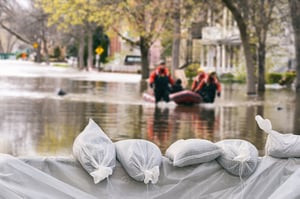How Prepared is Your Credit Union in the Event of a Natural Disaster?
 As evident by the coverage in our everyday news cycle, the last few years seem to have shown an increase in the number of hurricanes, floods, fires and other natural disasters. If the climate scientists prove correct, the increasing intensity of future storms will likely lead to a corresponding increase in devastation and losses, making recovery efforts more challenging for credit unions and their communities. This makes the importance of a disaster recovery plan for your credit union even more imperative. The ability to function, even in a modified, smaller capacity is something your employees and members will find extremely important in those difficult times.
As evident by the coverage in our everyday news cycle, the last few years seem to have shown an increase in the number of hurricanes, floods, fires and other natural disasters. If the climate scientists prove correct, the increasing intensity of future storms will likely lead to a corresponding increase in devastation and losses, making recovery efforts more challenging for credit unions and their communities. This makes the importance of a disaster recovery plan for your credit union even more imperative. The ability to function, even in a modified, smaller capacity is something your employees and members will find extremely important in those difficult times.
A credit union in California has seen more than their fair share of natural disasters, from earthquakes, flooding and mudslides, to devastating forest fires. To make things go smoothly, they have compiled a list of recommendations for how to best prepare in the event of an emergency. Here are some suggestions of what worked for them and what matters most:
- Create a plan for business continuity. Members need urgent access to their money during and after a disaster, and they’re depending on you to provide that.
- Have a strong communications plan in place. Being able to reach your leaders, your staff and your service providers is essential. With a strong communications plan, you can quickly ensure staff is safe, and help secure lodging for those who need it. Consider implementing a text alert system that will allow you to send real-time alerts and updates to all staff in the event of an emergency.
- Keep members informed. Use your website, email and social media to provide service updates so members know what to expect and how they can access their money.

Part of that business continuity is being able to conduct business, even if it’s limited initially. For example, after Hurricane Katrina, a credit union in New Orleans had to think a bit out of the box in order to communicate with its members due to the lack of electricity. Many members were concerned about whether their direct deposits and Social Security payments had been posted. To find out that information, members were driving to the branch to ask questions. To make things simpler, the credit union put yard signs in front of the branch and wrote the dates of the direct deposits that had been posted and when members could expect to have access to their money. They also used social media to communicate this information quickly to the public.
Protection of your data is always important, but even more imperative in this situation. Partner with a core technology provider that can work with you and your team to ensure data remains safe and uncompromised. Discuss ways to have the data accessed quickly in order to provide members with answers and deliver funds as soon as possible. Make sure your credit union has an IT backup location in a different geographical area to ensure online and mobile services can continue to function. Test and retest your disaster recovery plan for your credit union core with your core provider to ensure there are no holes.



